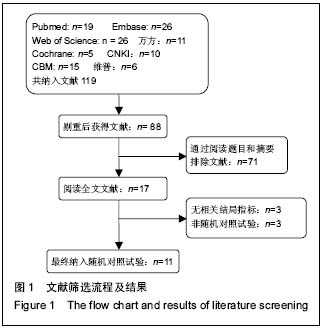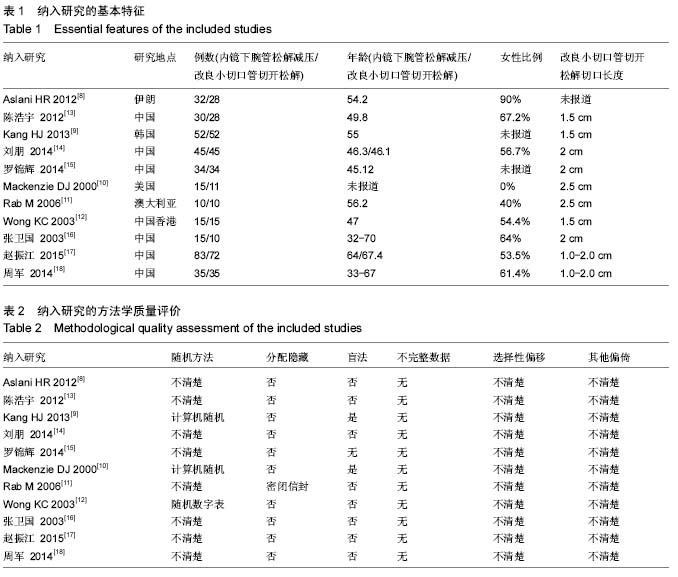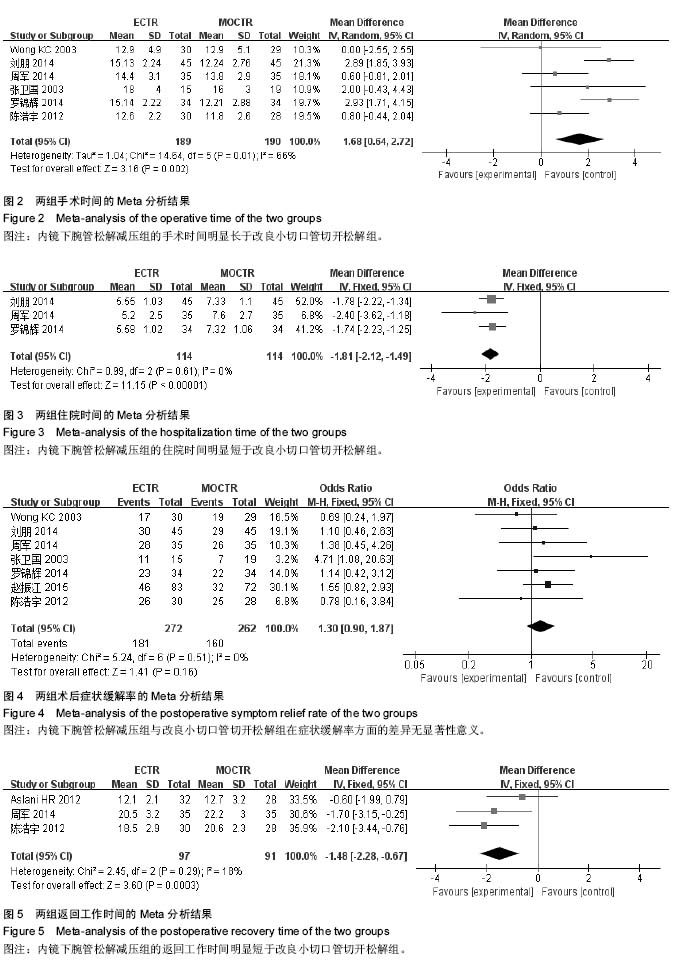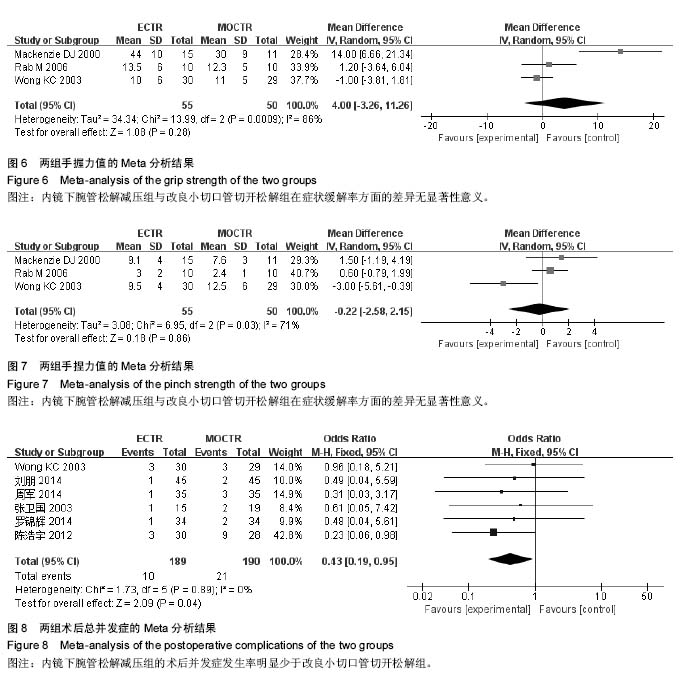中国组织工程研究 ›› 2016, Vol. 20 ›› Issue (33): 5009-5016.doi: 10.3969/j.issn.2095-4344.2016.33.020
• 组织构建循证医学 evidence-based medicine in tissue construction • 上一篇
腕管综合征神经卡压:内镜下腕管松解与有限小切口松解的效果及安全性评价
白 杰,许玉本,夏 雷,周海振
- 西安市红会医院手外二科,陕西省西安市 710054
The clinical efficacy and safety of endoscopic release versus mini-open release for carpal tunnel syndrome
Bai Jie, Xu Yu-ben, Xia Lei, Zhou Hai-zhen
- Second Department of Hand Surgery, Honghui Hospital of Xi’an, Xi’an 710054, Shaanxi Province, China
摘要:
文章快速阅读:
.jpg) 文题释义:
内镜下腕管松解减压:1987 年,Okutsu等首次采用内镜下腕管松开减压术,可分两大类:单切口技术和双切口技术。内镜下腕管松开减压术的优势在于腕横韧带在腕管内被横断,且正中神经的覆盖组织得以保留,这能降低术后复发率,加快术后恢复。其优点主要是可以缩短术后手部功能障碍的时间,减少术后疼痛及无力的症状,使患者早期自理生活和恢复工作,节省经济费用。
小切口管切开松解:自1991年以来,许多术者通过使用开放式小切口技术(2.0-3.0 cm)。小切口行腕管松解减压术的疗效确切、切口小、组织创伤小、术后瘢痕小、手术耗时少、康复期短、少有瘢痕增生及疼痛,并可根据需要延长切口,虽然显露不充分,操作不便。
文题释义:
内镜下腕管松解减压:1987 年,Okutsu等首次采用内镜下腕管松开减压术,可分两大类:单切口技术和双切口技术。内镜下腕管松开减压术的优势在于腕横韧带在腕管内被横断,且正中神经的覆盖组织得以保留,这能降低术后复发率,加快术后恢复。其优点主要是可以缩短术后手部功能障碍的时间,减少术后疼痛及无力的症状,使患者早期自理生活和恢复工作,节省经济费用。
小切口管切开松解:自1991年以来,许多术者通过使用开放式小切口技术(2.0-3.0 cm)。小切口行腕管松解减压术的疗效确切、切口小、组织创伤小、术后瘢痕小、手术耗时少、康复期短、少有瘢痕增生及疼痛,并可根据需要延长切口,虽然显露不充分,操作不便。
.jpg) 文题释义:
内镜下腕管松解减压:1987 年,Okutsu等首次采用内镜下腕管松开减压术,可分两大类:单切口技术和双切口技术。内镜下腕管松开减压术的优势在于腕横韧带在腕管内被横断,且正中神经的覆盖组织得以保留,这能降低术后复发率,加快术后恢复。其优点主要是可以缩短术后手部功能障碍的时间,减少术后疼痛及无力的症状,使患者早期自理生活和恢复工作,节省经济费用。
小切口管切开松解:自1991年以来,许多术者通过使用开放式小切口技术(2.0-3.0 cm)。小切口行腕管松解减压术的疗效确切、切口小、组织创伤小、术后瘢痕小、手术耗时少、康复期短、少有瘢痕增生及疼痛,并可根据需要延长切口,虽然显露不充分,操作不便。
文题释义:
内镜下腕管松解减压:1987 年,Okutsu等首次采用内镜下腕管松开减压术,可分两大类:单切口技术和双切口技术。内镜下腕管松开减压术的优势在于腕横韧带在腕管内被横断,且正中神经的覆盖组织得以保留,这能降低术后复发率,加快术后恢复。其优点主要是可以缩短术后手部功能障碍的时间,减少术后疼痛及无力的症状,使患者早期自理生活和恢复工作,节省经济费用。
小切口管切开松解:自1991年以来,许多术者通过使用开放式小切口技术(2.0-3.0 cm)。小切口行腕管松解减压术的疗效确切、切口小、组织创伤小、术后瘢痕小、手术耗时少、康复期短、少有瘢痕增生及疼痛,并可根据需要延长切口,虽然显露不充分,操作不便。摘要
背景:研究已经证实,相比腕管切开减压,内镜下腕管松解减压在术后恢复工作时间、手握力、手捏力、住院时间以及术后瘢痕组织发生率方面有一定的优势。
目的:系统评价内镜下腕管切开减压与小切口开放腕管切开减压治疗腕管综合征的临床疗效和安全性。
方法:计算机检索PubMed、the Cochrane Library、EMbase、Web of Science、CNKI、维普和万方数据库,纳入对比内镜下腕管松解减压术与改良小切口管切开松解术治疗腕管综合征的相关随机对照试验,检索时间截止2005年11月1日。由2位作者独立筛选文献、提取资料以及对纳入研究的质量进行偏倚风险评价。统计分析采用RevMan 5.3软件。
结果与结论:共纳入11个RCT(706例患者)。分析结果显示,①相比改良小切口管切开松解,内镜下腕管松解减压能缩短住院时间(P < 0.05)、提高术后症状缓解率(P=0.16),减少返回工作时间(P < 0.05)和降低术后总并发症(P < 0.05);②在手握力值和手捏力值方面,两组之间的差异无显著性意义。③结果说明,与小切口腕管切开减压相比,内镜下腕管松解减压在住院时间、返回工作时间、术后症状缓解率方面有一定的优势,且有更低的术后并发症发生率,但仍需要大样本、高质量的随机对照试验来验证此次分析结果。
中国组织工程研究杂志出版内容重点:组织构建;骨细胞;软骨细胞;细胞培养;成纤维细胞;血管内皮细胞;骨质疏松;组织工程
ORCID: 0000-0002-4534-956X(许玉本)
中图分类号:




.jpg) 文题释义:
内镜下腕管松解减压:1987 年,Okutsu等首次采用内镜下腕管松开减压术,可分两大类:单切口技术和双切口技术。内镜下腕管松开减压术的优势在于腕横韧带在腕管内被横断,且正中神经的覆盖组织得以保留,这能降低术后复发率,加快术后恢复。其优点主要是可以缩短术后手部功能障碍的时间,减少术后疼痛及无力的症状,使患者早期自理生活和恢复工作,节省经济费用。
小切口管切开松解:自1991年以来,许多术者通过使用开放式小切口技术(2.0-3.0 cm)。小切口行腕管松解减压术的疗效确切、切口小、组织创伤小、术后瘢痕小、手术耗时少、康复期短、少有瘢痕增生及疼痛,并可根据需要延长切口,虽然显露不充分,操作不便。
文题释义:
内镜下腕管松解减压:1987 年,Okutsu等首次采用内镜下腕管松开减压术,可分两大类:单切口技术和双切口技术。内镜下腕管松开减压术的优势在于腕横韧带在腕管内被横断,且正中神经的覆盖组织得以保留,这能降低术后复发率,加快术后恢复。其优点主要是可以缩短术后手部功能障碍的时间,减少术后疼痛及无力的症状,使患者早期自理生活和恢复工作,节省经济费用。
小切口管切开松解:自1991年以来,许多术者通过使用开放式小切口技术(2.0-3.0 cm)。小切口行腕管松解减压术的疗效确切、切口小、组织创伤小、术后瘢痕小、手术耗时少、康复期短、少有瘢痕增生及疼痛,并可根据需要延长切口,虽然显露不充分,操作不便。